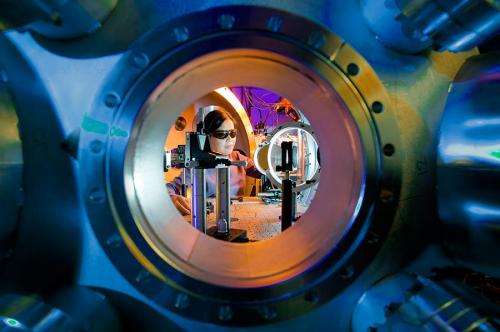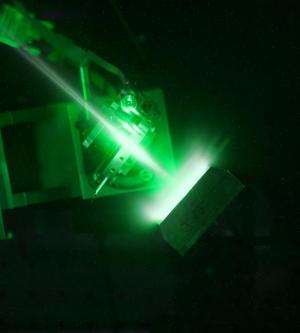LLNL researchers define boundaries for petawatt laser absorption

(Phys.org) —The absorption of petawatt (1015 watts) laser light by solid matter is a crucial problem that has been the subject of theoretical and experimental study for more than two decades. In a newly-published paper, Lawrence Livermore scientists have defined, for the first time, a set of theoretical boundaries for the absorption of petawatt laser light. The scientists present their research in the June 18 online edition of Nature Communications.
"Petawatt lasers are the most powerful light sources ever created on earth," said Matthew Levy, lead author and Lawrence Scholar in the Physics Division at LLNL. "What we have done here is to reveal the fundamental limits on how they interact with dense matter, converting laser energy to particle energy."
Irradiation of solids by petawatt laser light creates extreme states of matter with temperatures exceeding 10 million degrees Celsius and pressures exceeding 1 billion earth atmospheres. These high energy density conditions are driven by violent absorption processes, which can accelerate electrons from rest to 99.9 percent of the speed of light over just a few microns. Suitably harnessed, these conditions open the way to advanced scientific applications such as compact radiation sources, laser fusion, laboratory astrophysics and ultrafast imaging systems.
"The potential for breakthrough scientific applications is very high," Levy said. "But because the interaction is so nonlinear, a key outstanding problem has been predicting the amount of light absorbed. The new analysis that we have developed reveals the theoretical upper and lower limits."

In the paper, LLNL researchers present an advanced theoretical model of the absorption of these powerful lasers. "Essentially what we have developed is a formalism for intense laser interactions with dense matter that is analogous to the Rankine-Hugoniot relations for shockwaves," Levy said. They then show close agreement between the absorption bounds and more than 75 experimental data points and simulation results, covering multiple laser wavelengths, intensities, polarizations and target materials, helping to confirm the theory. "These are natural bounds which emerge from our analysis," Levy noted. "Defining them leads to a greater understanding of petawatt laser-solid physics today and drives alternative research paths where the desired results lie beyond those bounds."
Since the majority of experiments today use solid targets, these new findings should significantly impact the development of future high power laser applications. Where researchers need performance exceeding that permitted by the absorption bounds, Levy noted that "these results will accelerate a shift away from solid targets across the petawatt laser community, leading the development of structured targets and new materials."
More information: "Lighting a new era of scientific discovery" is available online: str.llnl.gov/content/pages/jan … 2014/pdf/01.14.1.pdf
The paper titled "Petawatt laser absorption bounded" is available online: www.nature.com/ncomms/2014/140 … 9/pdf/ncomms5149.pdf
Journal information: Nature Communications
Provided by Lawrence Livermore National Laboratory



















